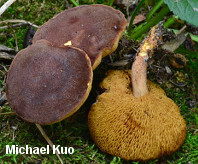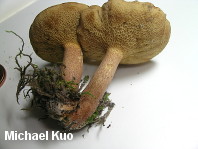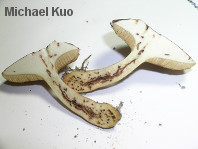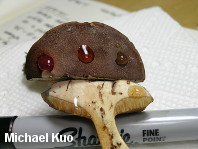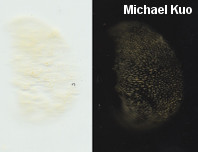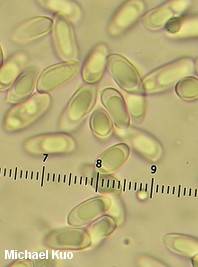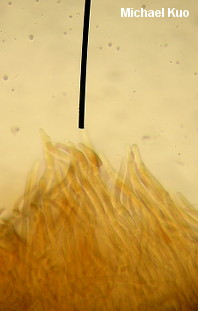| Major Groups > Boletes > Bothia castanella |

|
Bothia castanella [ Basidiomycota > Boletales > Boletaceae > Bothia . . . ] by Michael Kuo This distinctive and odd bolete, found east of the Rocky Mountains (usually under oaks), has a soft, brown cap and a dull yellow, boletinoid pore surface that begins to run down the stem and bruises slowly brown to reddish brown. The apex of the stem is widely reticulate with a brown reticulum. It can be similar in general appearance to Xerocomus subtomentosus, but that species is usually larger and has a pore surface that turns olive with maturity and is not truly boletinoid, along with a paler cap surface that turns dark mahogany red (rather than merely pinkish) with ammonia. Under the microscope, Bothia castanella features ellipsoid spores that are very different from the subfusoid to fusoid spores of most boletes (including Xerocomus subtomentosus). Bothia castanella has a long history of defying comfortable placement in any of the established bolete genera. Peck (1900) originally placed the species in Boletinus; it has also been placed in Boletinellus, Gyrodon, Xerocomus, and Chalciporus. Since its boletinoid pore surface is suggestive of Suillus, Smith & Thiers (1964) were led to place it in that genus, but they had never seen the mushroom in the fresh state, and based their decision on analysis of one crusty herbarium collection made by Smith's mentor, 40 years earlier--and the species lacks any of the other classic Suillus features (association with conifers, slimy cap, cinnamon brown spore print, and so on). In 2007, Halling and collaborators decided that "[t]he combination of macro- and micromorphological features is foreign to any known bolete genus, and generic recognition is supported further with molecular phylogenetic data," proposing the single-species genus Bothia. Description: Ecology: Mycorrhizal with oaks; growing alone, scattered, gregariously, or in loose clusters; summer and fall; possibly widely distributed east of the Rocky Mountains. The illustrated and described collection is from Illinois. Cap: 3.5-6 cm, convex when young, becoming broadly convex or nearly flat; soft; dry; finely velvety when young, but often becoming more or less bald; medium brown to dark brown. Pore Surface: Beginning to run down the stem; angular and radially arranged (boletinoid); dull golden yellow at first, becoming brownish yellow but not developing olive shades; bruising slowly brown to reddish brown; pores 1-3 mm across at maturity; tubes 3-5 mm deep. Stem: 3-5 cm long; 5-8 mm thick; more or less equal, or with a gracefully club-shaped base and a slightly flared apex; widely brown-reticulate near the apex; elsewhere more or less bald; dull yellow near the apex; brownish to brown below; basal mycelium white. Flesh: Whitish in cap; whitish to pale yellow in stem; not staining when sliced. Odor and Taste: Not distinctive. Chemical Reactions: Ammonia pinkish on cap surface, negative on flesh. KOH dull orange on cap surface; negative to orangish on flesh. Iron salts negative to grayish on cap surface; negative to bluish gray on flesh. Spore Print: Dull yellow. Microscopic Features: Spores 6-13 x 3.5-4.5 µ; ellipsoid; smooth; hyaline and uni- to biguttulate in KOH. Hymenial cystidia narrowly fusiform to fusoid-ventricose; to 25-65 x 5-10 µ. Pileipellis a collapsing trichoderm of elements 5-7.5 µ wide, golden orangish brown in KOH; terminal cells tubular-cylindric, with rounded apices. REFERENCES: (Peck, 1900) Halling, T. J. Baroni & Manfr. Binder, 2007. (Saccardo, 1902; Murrill, 1909; Snell & Dick, 1958; Smith & Thiers, 1964; Smith, Smith & Weber, 1981; Both, 1993; Bessette, Roody & Bessette, 2000; Roody, 2003; Binion et al., 2009.) Herb. Kuo 08301401. This site contains no information about the edibility or toxicity of mushrooms. |
© MushroomExpert.Com |
|
Cite this page as: Kuo, M. (2015, January). Bothia castanella. Retrieved from the MushroomExpert.Com Web site: http://www.mushroomexpert.com/bothia_castanella.html |
